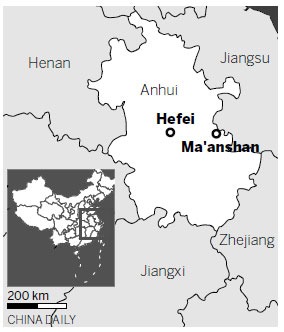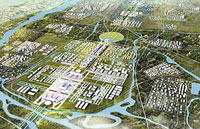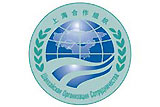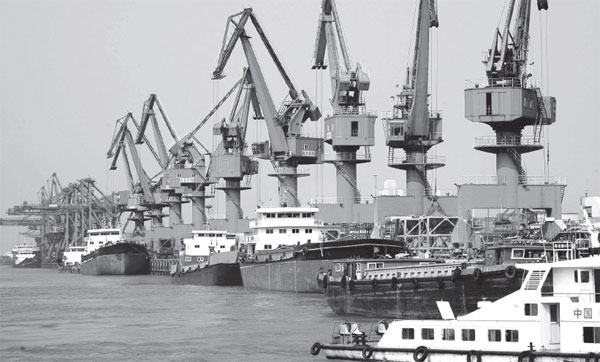Anhui Special: Port project to boost Anhui's economic development
Updated: 2014-12-18 08:02
By Zhu Lixin and Fang Ping(China Daily USA)
|
|||||||||
Ma'anshan on the Yangtze River plans to play a larger role in the future development of Anhui province, the newest member of the Yangtze River Delta region.
In Shanghai on Dec 2, Party chiefs and governors from Jiangsu, Zhejiang and Anhui provinces and Shanghai city, gathered for a seminar on the Yangzte River Delta, one of the country's most developed regions.
The meeting marked the formal recruitment of Anhui into the union.
|
Ma'anshan port, one of the busiest ports along the Yangtze River, is a Class A port open to foreign ships. It was also one of the first ports to allow direct sailing routes between the Chinese mainland and Taiwan. Provided to China Daily |
To consolidate its economic strength, Anhui has tried to make a better use of its water transport, a plan that matched China's aim to increase its dependence on the Yangtze River.
The State Council released a guideline, on Sept 25, to promote the Yangtze River economic belt into a new engine for the economic development of the whole region.
The belt covers nine provinces and two cities, 20 percent of the country's land area and 40 percent of its GDP.
"The trunk river now sees an annual cargo throughput of more than 2 billion tons, the largest among all the world's inland rivers," said Zhang Xiaowen, chief engineer of the Transport Planning and Research Institute of the Ministry of Transport.
"Twelve ports along the river reported a cargo throughput of more than 100 million tons in 2013, but most of them are located along the river's lower reaches," he added.
The Yangtze River and its tributaries boast a total navigable length of more than 70,000 kilometers, which makes it the major water transport artery between west and east.
"Coastal provinces and cities were the first to open to the world through the country's reform and opening-up process, but a more developed river transport system can offer inland cities equal access to the world," said Wei Yao, mayor of Ma'anshan.
China is home to seven of the world's 10 busiest ports, but the world's second largest economy's logistics performance only ranks 28th in the world, according to the Logistics Performance Index by the World Bank.
"China's logistics costs take up 18 percent of the country's GDP, while the percentage of developed countries are as low as 9 percent," said Zhang.
"China is now offering various economic initiatives to the world, including the Silk Road Economic Belt and the 21st Century Maritime Silk Road. Construction of ports along the Yangtze river will play a more important role in facilitating the economy," said Ye Jian, head of the China Association of Portof-Entry.
Anhui wants to take advantage of the opportunities and took action in early 2012 to get ahead of other provinces.
The province focused on the development of Ma'anshan port, which borders Nanjing, the capital of Jiangsu province, and is one of the country's major inland ports.
Ma'anshan port was one of the first ports to allow direct sailing routes between the Chinese mainland and Taiwan.
In 2013, the port saw a foreign trade cargo throughput of 11 million tons, 70 percent of the whole province's total.
The annual gross cargo throughput reached more than 75 million tons in the same year and is expected to surpass 100 million tons soon. Ma'anshan was established in 1956 and is known as a steel city. The Ma'anshan Iron and Steel Group is the country's ninth largest steel maker.
Most of the cargo transported to and from Ma'anshan port is coal, iron ore and steel products. The province is also home to several other large manufacturing companies, including cement and car makers.
After rapid economic development of both the city and the province, the port no longer met the needs of the local economy.
Therefore the province planned to consolidate its water transport strength by building Zhengpu Port, a new port in Ma'anshan.

Work started on Zhengpu Port in January 2012 and it is due to begin operating by the end of December.
The port will be the last port along the Yangtze River to permit vessels with more than 10,000 tons of loading capacity.
Construction of three berths for ships of 5,000 tons, which constitute phase one of the port development, were finished in early December.
Phase one also allows vessels of up to 20,000 tons to berth. Phase two of the project will handle ships of up to 80,000 tons and long-term plans include construction of 26 berths for 10,000-ton vessels.
The whole port project is expected to include total investment of more than 10 billion yuan and will see cargo throughput capacity of more than 100 million tons upon completion.
Of Ma'anshan's 37.16 kmlong riverbank, only 34 percent has been developed.
"The Yangtze River watercourse in Ma'anshan maintains a depth of more than nine meters all year round, which allows the passing of ships up to 100,000 tons," said Ji Xiang, deputy mayor of Ma'anshan.
"The depth of the inner-Ma'anshan watercourse is unsurpassable to the upper reaches. It is indeed a great advantage we can make use of," he added.
The port project is expected to help Anhui-based enterprises cut logistics costs by 30 percent, compared to sending goods to Nanjing Port, and save much more, compared to sending cargo to Shanghai Port, according to Zhang.
Contract the writer at zhulixin@chinadaily.com.cn
(China Daily USA 12/18/2014 page14)

 China's 10 major economic policies in 2014
China's 10 major economic policies in 2014
 Beeper collector brings back the vintage digital age
Beeper collector brings back the vintage digital age
 10 bad behaviors of Chinese drivers
10 bad behaviors of Chinese drivers
 Yearender: Honors achieved in 2014
Yearender: Honors achieved in 2014
 Surprising techniques to relieve stress
Surprising techniques to relieve stress
 Yearend Review 2014 -Best of Animals
Yearend Review 2014 -Best of Animals
 Premier: In between the meetings
Premier: In between the meetings
 Chinese VP speaks at food cooperation forum in Chicago
Chinese VP speaks at food cooperation forum in Chicago
Most Viewed
Editor's Picks

|

|

|

|

|

|
Today's Top News
New dynamic as US, Cuba restore relations
China set to make tracks for Europe
US moves to normalize relations with Cuba
Russians flock to stores to pre-empt price rises
New York premiere of DPRK comedy canceled after threat
Wal-Mart bullish over Sam's Club
Beijing hotel recognized for excellence
Li makes pitch for business investment
US Weekly

|

|









